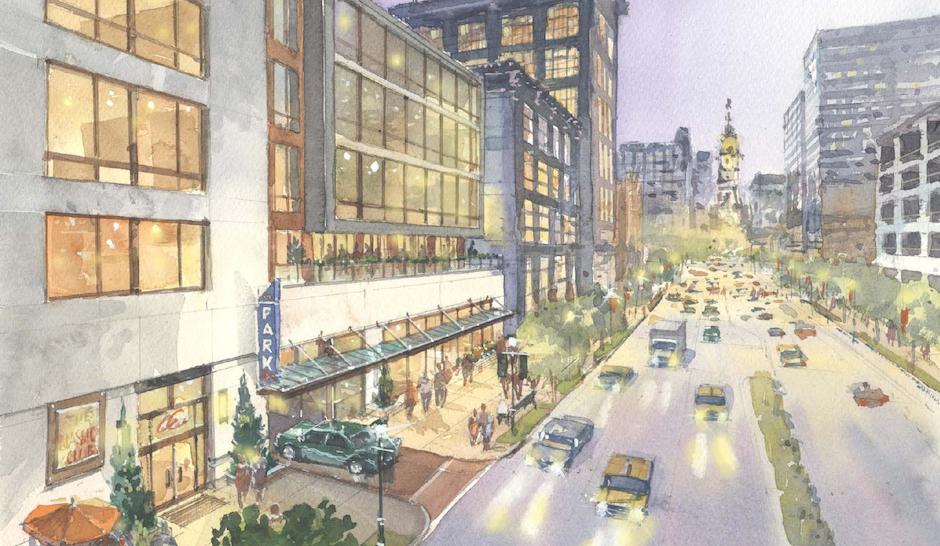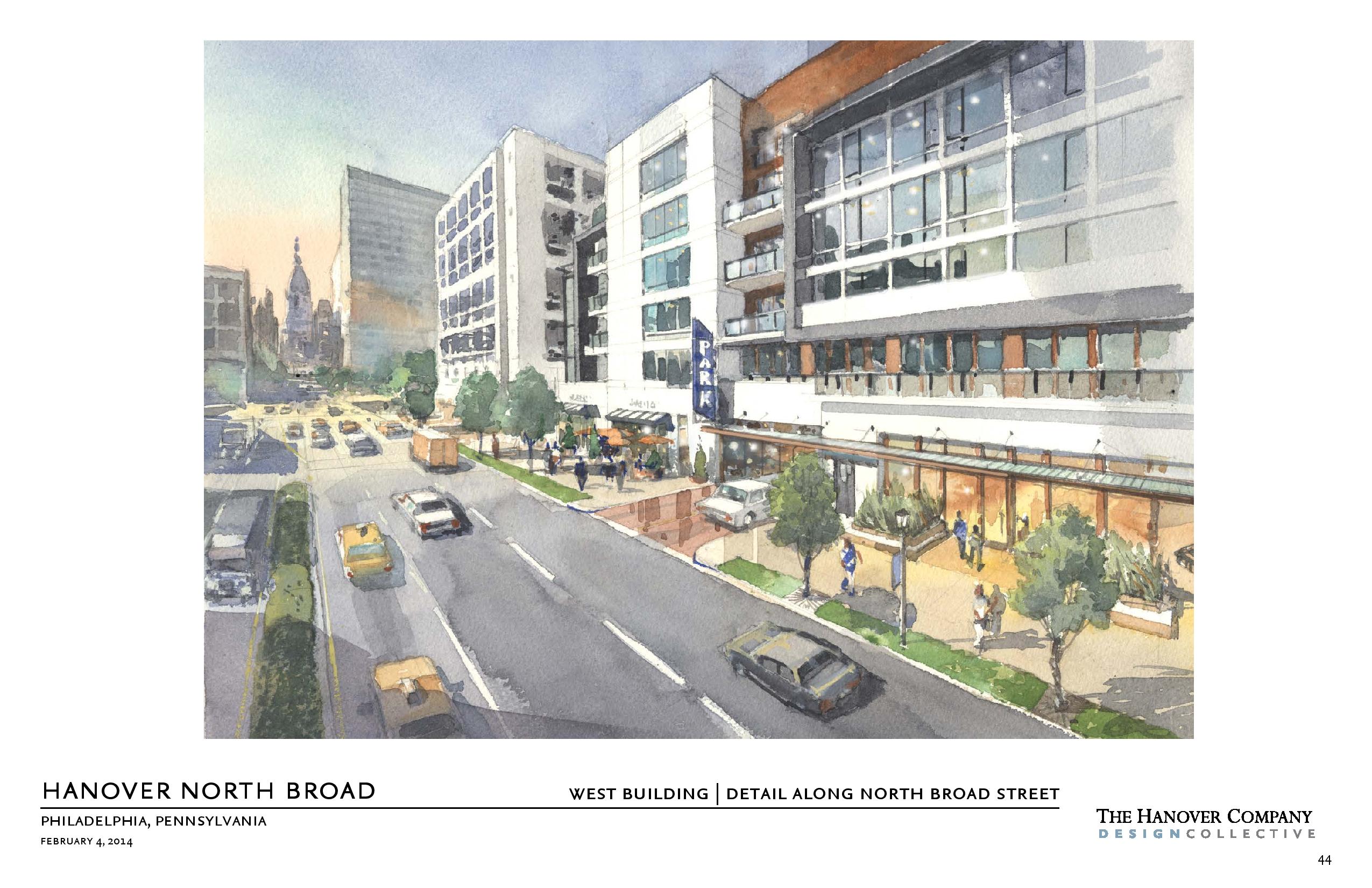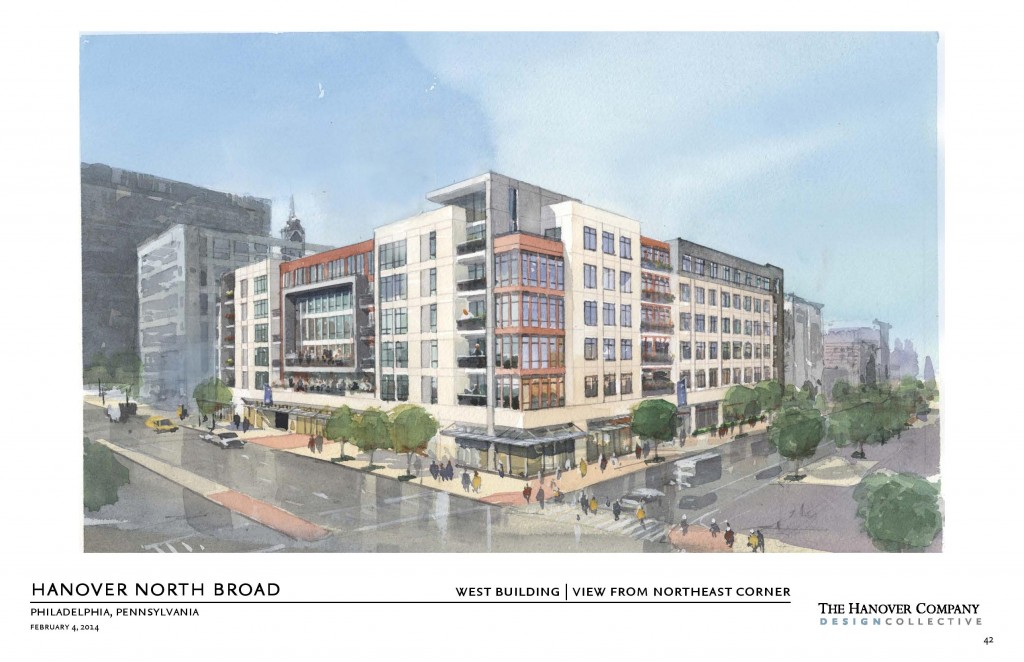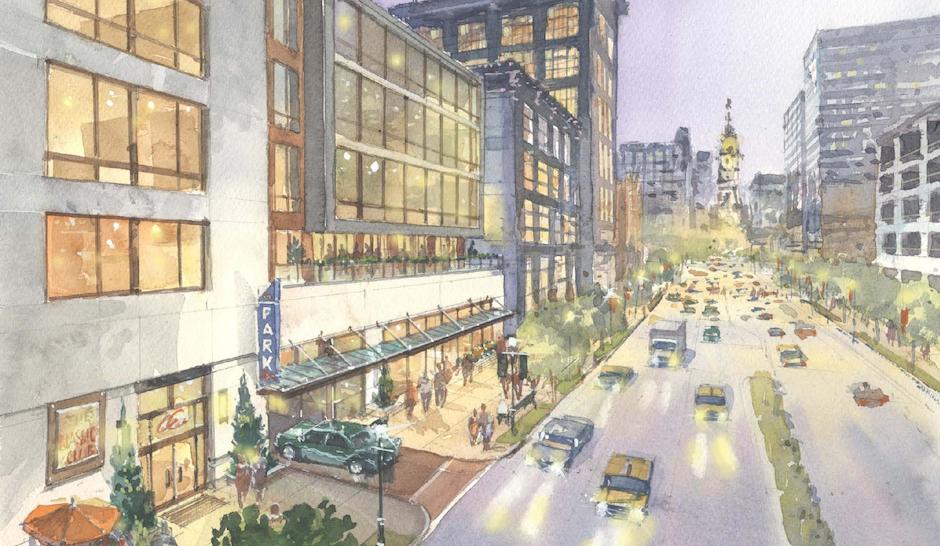PCPC supports apartments at Broad and Callowhill, demands better response to design committee

Developers Hanover North Broad and Parkway Corporation got the support of the Philadelphia City Planning Commission for the 12 zoning variances they will need to build 339 apartments in two buildings at 339 and 322-44 North Broad Street.
In addition to the residences, the project, planned for what are now surface parking lots on the east and west sides of Broad at Callowhill, will also include ground-floor retail and indoor parking for both residents and the general public. Adam Harbin, development partner with The Hanover Company, said the team is “in discussion with several destination-type restaurants.”
While supporting the variances, which are related to signage, driveway width and terrace setback, and liking the project in general, several planning commissioners were unhappy with one element of the presentation: It wasn’t clear to them exactly what changes were made in response to suggestions raised at the Feb. 4 Civic Design Review hearing.
Commissioner Nancy Rogo Trainer, who chairs the CDR committee, and Commission Vice Chairman Joe Syrnick, who led Tuesday’s meeting, said this problem was not limited to one project, and it could render the CDR process meaningless if allowed to continue unchecked.
There’s no point in CDR review if developers aren’t held responsible for responding to the concerns raised, Syrnick said. “CDR has to mean something,” Trainer said. “If all we are is a way of keeping design discussion out of this room, we haven’t done our job.”
Trainer said she’s asked staff to configure future presentations so that specific changes related to CDR concerns and suggestions are detailed and illustrations clearly showing the developer’s intent are included.
CDR suggestions for the Hanover/Parkway project included changing the garage doors and other design elements related to the garage, coordinating with the Avenue of the Arts on streetscape design, narrowing a 24-foot entrance on the West Side of Broad Street, and designing the indoor parking space so that it could be converted to additional retail if the market will support that in the future.
After the PCPC staff presentation by Planner Anthony Santaniello,Trainer wanted details on changes the developer made in response to those suggestions. She asked Santaniello if the developer found alternatives to roll-up metal doors for the garage entrance on Callowhill Street. He said the gates were changed. But Trainer said the developer needed to illustrate the changes, not just say they were being made.
“Saying they were revised is not the same as showing they were revised,” Trainer said. “This is frustrating to me right now. If we’re going to give Civic Design Review any meaning, you have to explain the changes, and demonstrate what they are.”
Project attorney Tony Forte, of Saul Ewing, said the team had received a written summary of CDR concerns and had responded in kind to the PCPC with a detailed memo addressing each item, which he assumed would be distributed to the commission. “Were there drawings with the memo?” Trainer asked. “We submitted a whole revised package,” Forte said.
Forte said the design was changed so that the sidewalk paving is uniform, even at garage entrances, and contact has been made with the Avenue of the Arts. The entrance on the west side of Broad Street was shrunk from 24 feet to 22 feet, he said, and markings were changed so it’s clear only one car at a time can use it.
While the retail areas mostly front Broad Street, they now wrap around to Callowhill, Forte said. Trees were moved from grassy-looking areas to planters.
“We asked our design team to refine the design to make sure (parking space) could easily be converted (to retail/commercial),” Forte said. Part of the parking area “could convert to 3,000 square foot retail with very high ceilings. But we don’t believe the market conditions can support it now, and we do need the parking.”
Forte’s description did not make Trainer happy. She said CDR does not insist on trees in pots, and if trees will grow in the ground, the developer should plant them. CDR understands the need for parking, and took no exception to it, she said. The problem was the door treatment, “And I didn’t hear that addressed.”
Project architect Tom Zeigenfuss, of the Baltimore-based Design Collective, said the problem was only about words. Metal roll-up doors create a certain mental image, he said, but these are not the typical type. They will be specially designed and attractive.
“It’s not just words,” Trainer said. Trainer noted that she supports the project, which Santaniello said would help bring more residents to Center City, a key goal in the Central District comprehensive plan. “I think it’s a very good project,” she said. Her comments about needing more detail, and illustrations, of CDR-inspired changes were “more a response to the CDR process than to this project.”
Syrnick said in cases where a portion of a project hasn’t yet been designed, developers should bring photos of other projects that show the concepts of what they have in mind.
“If they show us a picture, but it may change, how can we have any assurances” that a developer won’t build something the commission wouldn’t approve of, Commissioner Nilda Ruiz asked.
Change is understandable, Trainer said. The illustrations “set an expectation of quality.”
Syrnick said a certain degree of trust was necessary, but he would hope any changes would be just as good or better than what is presented.
The Broad and Callowhill project heads to the Zoning Board of Adjustment on March 19.
WHYY is your source for fact-based, in-depth journalism and information. As a nonprofit organization, we rely on financial support from readers like you. Please give today.






